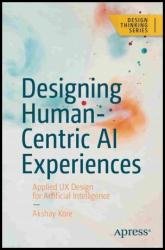 Название: Designing Human-Centric AI Experiences: Applied UX Design for Artificial Intelligence
Название: Designing Human-Centric AI Experiences: Applied UX Design for Artificial IntelligenceАвтор: Akshay Kore
Издательство: Apress
Год: 2022
Страниц: 478
Язык: английский
Формат: pdf (true)
Размер: 13.8 MB
User Experience (UX) design practices are evolving as more and more software products incorporate Machine Learning (ML) components and Artificial Intelligence (AI) algorithms at their core. AI brings a fundamental shift to how we design products. Instead of programming a system to do a specific action, AI teams are responsible for curating outcomes based on algorithms and large amounts of data. AI systems are dynamic, they change over time, and their user experience needs to adapt to this change. The complexity of these systems requires deeper collaborations with various disciplines.
The dynamic nature of AI systems calls for a shift in how we think about designing intelligent products and how we work, communicate and collaborate within teams. 'Designing Human-Centric AI Experiences' will explore this problem and address the challenges and opportunities in UX design for AI/ML systems. We look at best practices for designers, managers, and product creators and describe how individuals from non-technical backgrounds can collaborate effectively with AI and Machine learning teams.
Machine Learning or ML is a type of AI technique that uses the examplesbased approach. With Machine Learning, the system can accomplish tasks without giving any specific instructions. The AI system starts forming patterns that help it match input to the desired output by showing it lots of examples. We are essentially teaching machines how to learn. It builds a mathematical function for this input-output mapping. We call this mathematical function the ML model. To teach a machine, we provide it with lots of data. We divide this data into a training and test set. The kind of data provided depends on the goals of the AI system you are building. For example, to create a face recognition system, you might give the machine lots of pictures of faces.
Overview of chapters
This book is divided into four parts:
Part 1 (Intelligence) comprises chapters 1 and 2. We discuss the idea of intelligence, the many meanings of AI, and the view of Artificial intelligence this book subscribes to.
Part 2 (Decisions) consists of chapter 3, which talks about making decisions regarding incorporating AI in your workflows and finding opportunities for using it in your organization.
Part 3 (Design) focuses on specific design patterns, techniques, and ethical considerations for designing human-centric AI products. This section consists of chapters 4 to 8.
Part 4 (Teamwork) describes how designers can communicate and collaborate effectively with AI tech teams and consists of chapters 9 and 10. This section introduces essential AI terminologies, behaviors, and mindsets to help you become an impactful and effective team member.
You will Learn:
How to spot opportunities for applying AI in your organization
Advantages and limitations of using AI to solve problems
Best practices in UX design to build human-centric and ethical AI products
How to collaborate and communicate effectively with AI/ML tech teams
How to Use This Book:
I wrote this book as a practical guide to designing human-centric AI products. And even though I’ve written this book, I’m pretty sure I will have to keep going back to refer to sections from time to time. The pace at which we forget things is astonishing. While you might want to finish it in one go, in most cases, you will encounter different types of challenges at different times in your product development journey. I would recommend that you read it once and then use the book as a reference whenever you get stuck or when you want to explore different approaches to solve a problem with AI.
Скачать Designing Human-Centric AI Experiences: Applied UX Design for Artificial Intelligence